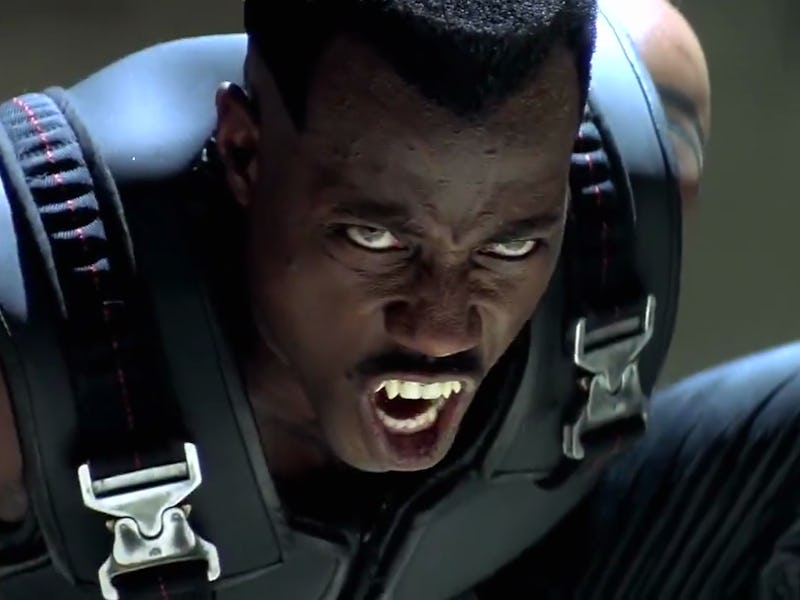What 'Blade' Can Teach Marvel's 'Doctor Strange' About Superhero Horror Movies
The weirdest Marvel film of the future could learn a few things from the weirdest Marvel film of the past.

It’s kind of crazy that Blade exists. The movie predates the vampire and superhero trend by at least a couple years, and yet, it’s a synthesis of the two concepts. In 1998, when the other superhero movies starred known entities like Batman, New Line Cinema made a film about a leather-clad, kung-fu vampire, played by Wesley Snipes, who fought other vampires at underground raves, and barely concealed sex dungeons.
However, none of that is an indictment of the film. Watching Blade today, it’s surprising how well the film holds up. Sure, the dialogue has aged poorly (“I’m gonna be naughty! I’m gonna be a naughty vampire god!”), but the action sequences and set design are still quite impressive for a film that didn’t rely heavily on CGI. In fact, the prop designs and combat scenes are my focus, here.
Doctor Strange, starring Benedict Cumberbatch and directed by Scott Derrickson (Sinister, Deliver Us from Evil) will be out later this year. Judging from the trailer, it’s clear that the film draws its influence from artistic works like M.C. Escher, Inception, The Matrix and other twisty mind-benders. Its mystical setting seems almost the polar opposite of the dark underworld portrayed in Blade, but the two Marvel properties are more alike than, say, Doctor Strange and Captain America: Civil War.
Doctor Strange
Like Guardians of the Galaxy before it, Doctor Strange will explore a part of the Marvel Cinematic Universe that feels very different than the pseudo-realistic world of the main Avengers cast (except maybe the Thor movies). As a result, Doctor Strange can’t really look towards other movies in the MCU for inspiration. This might be a blessing in a disguise, as Guardians of the Galaxy was left in a very similar position, only to become one of the best reviewed Marvel films to date.
That doesn’t mean Doctor Strange is completely alone in the realm of unique superhero movies either. Doctor Strange can learn a thing or two from films like Guillermo Del Toro’s Hellboy, and Blade is another surprising, early superhero film which lays a pretty good groundwork for some of the things that can be possible in a Doctor Strange film.
Doctor Strange
Why? Because aside from integrating superheroes into supernatural settings, the tones of both films (and Hellboy) are noticeably darker than the rest of Marvel’s offerings. Derrickson is a director who built his name on horror films, and while Del Toro actually only directed the second Blade film, he matched the tone of the first film, while improving on the style for the sequel. And while Doctor Strange will not be rated-R like the Blade films, the two movies offer successful examples of how to make a reliably dark, scary, action-packed thriller.
Practical Effects
From the set photos released and leaked for Doctor Strange, we can already gather that the movie will rely heavily on CGI. Turns out that’s just how films are made these days, but the quality of CGI has improved so much, that it almost doesn’t matter anymore. Did you know the airport fight scene in Civil War was almost all CGI? Still, that doesn’t mean you can’t blend the two seamlessly, especially when parts of your trailer look like they’ve been taken straight from a scene in The Matrix. Combining wire acrobatics and CGI can be used together seamlessly to create memorable stunts and fight sequences. Blade did so, and it was all the better for it. As one of the best choreographed superhero films of the 90s, Blade’s action sequences stand head and shoulders above the likes of Batman and Robin, and even much of the CGI heavy superhero films of the early 2000s.
Set Design
There’s a reason why the industrial design of Blade still holds up today. From the underground clubs to the armory run by Kris Kristofferson, the sets of Blade look like they were designed with purpose and function. Likewise, Doctor Strange will take the eponymous sorcerer to the far reaches of the world, like Nepal. While I imagine the scenes taking lace in other planes of existence will rely heavily on CGI magic, there’s no reason not to create scenes set in Nepal, or in the Sanctum Sanctorum in physical detail. The film, would benefit from some grounded design that pays tribute to the diverse architecture of the central Asian nation.
A very specific brand of horror
Doctor Strange (2015)
Blade was written in a decidedly tongue-in-cheek manner, but that didn’t stop the film from including scenes that were genuinely dark and terrifying. Likewise, just because Doctor Strange fits into the MCU mold, doesn’t mean that Derrickson can’t bring his long experience with terrifying horror films into Doctor Strange. A little shock and awe could go a long way, or a steady mix between the subtle darkness of Stephen Strange’s origin story, with the outright horror of whoever Mads Mikkelsen’s villain ultimately ends up being.
The Marvel studio system is so tightly controlled, many viewers wonder if there’s any room for improvisation within its ranks. Obviously films like Guardians of the Galaxy, and Captain America: The Winter Soldier buck that notion, but not enough to convince people that Marvel’s creative grip is nonexistent. Doctor Strange has the luxury of being so far out from the studio’s previous films, that it could easily go any which way it might please.